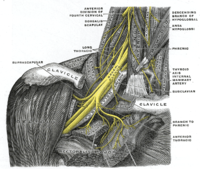
Photo from wikipedia
Dexmedetomidine prolongs the duration of regional block while its systemic sedative effect when administered perineurally is unknown. We aimed to evaluate the systemic sedative effect of perineural dexmedetomidine in patients… Click to show full abstract
Dexmedetomidine prolongs the duration of regional block while its systemic sedative effect when administered perineurally is unknown. We aimed to evaluate the systemic sedative effect of perineural dexmedetomidine in patients after axillary brachial plexus block (ABPB). This single-blinded prospective randomized control trial included 80 patients undergoing wrist surgery receiving ABPB. Patients were randomized into two groups – Control group (CG, N = 40) and dexmedetomidine group (DG, N = 40). Both groups received ABPB with 20 ml of 0.5% Bupivacaine and 10 ml of 2% Lidocaine. Additionally, patients in DG received 100 mcg of dexmedetomidine perineurally. Depth of sedation was evaluated using Narcontrend Index (NI) and Ramsay Sedation Scale (RSS) immediately after ABPB and in several time points up to 120 min. Duration of block as well as patient satisfaction with sedation was evaluated using a postoperative survey. Our results showed that NI and RSS statistically differed between groups, presenting a deeper level of sedation during the first 90 min in DG compared to controls, P < 0.001. In the first 10 to 60 min after ABPB the median RSS was 4 (IQR within median) and median NI was 60 (IQR 44–80) in DG group, in contrast to CG patients where median RSS was 2 (IQR within median) and median NI was 97 (IQR 96–98) throughout surgery. The level of sedation became equal in both groups 90 and 120 min after ABPB when the median NI value was 98 (97–99) in DG and 97.5 (97–98) in CG, P = 0.276, and the median RSS was 2 (IQR within median) in both groups, P = 0.128. No significant intergroup differences in hemodynamic or respiratory parameters were found. Patients in DG expressed satisfaction with sedation and 86.5% noted that the sensation was similar to ordinary sleep. In DG mean duration of motor block was 13.5 ± 2.1 h and sensory block was 12.7 ± 2.8 h which was significantly longer compared to CG 6.3 ± 1.5 h, P < 0.001 and 6.4 ± 1.8 h, P < 0.001. We found that beside prolongation of analgesia, perineural administration of dexmedetomidine might provide rather safe and comfortable sedation with no significant effect on hemodynamic or respiratory stability and yields a high level of patient satisfaction.
Journal Title: Frontiers in Medicine
Year Published: 2022
Link to full text (if available)
Share on Social Media: Sign Up to like & get
recommendations!